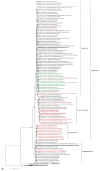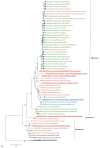Diversity of Coronaviruses in Wild Representatives of the Aves Class in Poland
- PMID: 34452362
- PMCID: PMC8402903
- DOI: 10.3390/v13081497
Diversity of Coronaviruses in Wild Representatives of the Aves Class in Poland
Abstract
The revealed prevalence of coronaviruses in wild bird populations in Poland was 4.15% and the main reservoirs were birds from orders Anseriformes and Charadriiformes, with a prevalence of 3.51% and 5.59%, respectively. Gammacoronaviruses were detected more often than deltacoronaviruses, with detection rates of 3.5% and 0.7%, respectively. Gammacoronaviruses were detected in birds belonging to six orders, including Anseriformes, Charadriiformes, Columbiformes, Galliformes, Gruiformes, and Passeriformes, indicating a relatively wide host range. Interestingly, this was the only coronavirus detected in Anseriformes (3.51%), while in Charadriiformes, the prevalence was 3.1%. The identified gammacoronaviruses belonged to the Igacovirus and Brangacovirus subgeneras. Most of these were igacoviruses and formed a common phylogenetic group with a Duck Coronavirus 2714 and two with an Avian Coronavirus/Avian Coronavirus9203, while the viruses from the pigeons formed a distinct "pigeon-like" group, not yet officially represented. The presence of deltacoronaviruses was detected in birds belonging to three orders, Charadriiformes, Galliformes, and Suliformes indicating a narrower host range. Most identified deltacoronaviruses belonged to the Buldecovirus subgenus, while only one belonged to Herdecovirus. Interestingly, the majority of buldecoviruses were identified in gulls, and they formed a distinct phylogenetic lineage not represented by any officially ratified virus species. Another separate group of buldecoviruses, also not represented by the official species, was formed by a virus identified in a common snipe. Only one identified buldecovirus (from common pheasant) formed a group with the ratified species Coronavirus HKU15. The results obtained indicate the high diversity of detected coronaviruses, and thus also the need to update their taxonomy (establishing new representative virus species). The serological studies performed revealed antibodies against an infectious bronchitis virus in the sera of white storks and mallards.
Keywords: Poland; coronavirus; wild birds.
Conflict of interest statement
The authors declare no conflict of interest.
Figures




Similar articles
-
Spotlight on avian coronaviruses.Avian Pathol. 2020 Aug;49(4):313-316. doi: 10.1080/03079457.2020.1761010. Epub 2020 Jun 4. Avian Pathol. 2020. PMID: 32374218
-
Avian Migration-Mediated Transmission and Recombination Driving the Diversity of Gammacoronaviruses and Deltacoronaviruses.Mol Biol Evol. 2025 Mar 5;42(3):msaf045. doi: 10.1093/molbev/msaf045. Mol Biol Evol. 2025. PMID: 39963938 Free PMC article.
-
Coronaviruses in wild birds - A potential and suitable vector for global distribution.Vet Med Sci. 2021 Jan;7(1):264-272. doi: 10.1002/vms3.360. Epub 2020 Sep 24. Vet Med Sci. 2021. PMID: 32970935 Free PMC article. Review.
-
Detection and characterisation of coronaviruses in migratory and non-migratory Australian wild birds.Sci Rep. 2018 Apr 13;8(1):5980. doi: 10.1038/s41598-018-24407-x. Sci Rep. 2018. PMID: 29654248 Free PMC article.
-
Birds as reservoirs: unraveling the global spread of Gamma- and Deltacoronaviruses.mBio. 2024 Oct 16;15(10):e0232424. doi: 10.1128/mbio.02324-24. Epub 2024 Sep 4. mBio. 2024. PMID: 39230281 Free PMC article. Review.
Cited by
-
First Report of Low Pathogenic Avian Influenza Subtype H9N2 in African Houbara Bustards (Chlamydotis undulata undulata) and Gamebirds in Morocco: Clinico-Pathological Findings, Molecular Characterization, and Associated Coinfections.Viruses. 2023 Dec 1;15(12):2374. doi: 10.3390/v15122374. Viruses. 2023. PMID: 38140613 Free PMC article.
-
Molecular Detection and Characterization of Coronaviruses in Migratory Ducks from Portugal Show the Circulation of Gammacoronavirus and Deltacoronavirus.Animals (Basel). 2022 Nov 25;12(23):3283. doi: 10.3390/ani12233283. Animals (Basel). 2022. PMID: 36496804 Free PMC article.
-
Genetic characterization of the first Deltacoronavirus from wild birds around Qinghai Lake.Front Microbiol. 2024 Jun 12;15:1423367. doi: 10.3389/fmicb.2024.1423367. eCollection 2024. Front Microbiol. 2024. PMID: 38933020 Free PMC article.
-
First Report of Alphacoronavirus Circulating in Cavernicolous Bats from Portugal.Viruses. 2023 Jul 8;15(7):1521. doi: 10.3390/v15071521. Viruses. 2023. PMID: 37515207 Free PMC article.
-
Detection and Prevalence of Coronaviruses in European Bats: A Systematic Review.Ecohealth. 2024 Dec;21(2-4):125-140. doi: 10.1007/s10393-024-01688-5. Epub 2024 Nov 23. Ecohealth. 2024. PMID: 39580592 Free PMC article.
References
-
- International Committee on Taxonomy of Viruses. ICTV Virus Taxononomy: 2019 Release. [(accessed on 3 September 2020)]; Available online: https://talk.ictvonline.org/taxonomy/
Publication types
MeSH terms
Grants and funding
LinkOut - more resources
Full Text Sources

